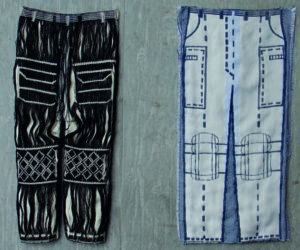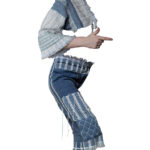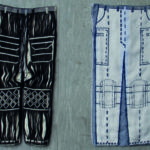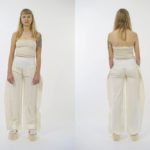 Graduate Research Weaver Profiles: Graysha Audren | Maike Jansen
Graduate Research Weaver Profiles: Graysha Audren | Maike Jansen
Seamless by Graysha Audren
Textile designer, Graysha Audren is a recent weave graduate of Central Saint Martins with a focus on sustainable innovation. She believes good designers are problem solvers at heart with the power to invoke change, disrupt systems, and design out inefficiencies. The textile industry interweaves global politics, economics, trade, society, and business. The industry is a web of complicated supply chains where sustainability needs design-led systemic transparency. To change the entire system and to affect real change, Graysha focuses holistically on questioning inefficient and unsustainable systems, starting at the beginning: the making of the cloth.
Her current project, Seamless, exhibited at the London Design Festival in partnership with Maison/0 and LVMH, proposes a revolutionary way of seamlessly weaving clothing for material waste reduction and supply chain efficiency. Every year, 48 million garments get produced globally1. In our conventional cut & sew production system, 15-25% of total fabric gets wasted to off-cuts and deadstock2. The growing demand for on-trend, low priced clothing incentivises manufacturers to cut costs, usually at the expense of the welfare and ethical working conditions of garment workers and the environment.
Engineering seamless woven clothing addresses these issues by reducing waste and taking unnecessary steps out of the supply chain. Garments are produced in 30 to 40% less time so that the increased efficiency and speed in manufacturing can cater to an on-demand, made-to-order system3. By only producing once the customer orders, there is zero dead stock and total material efficiency. Cost-effectiveness in manufacturing allows margins that can accommodate better wages and salaries and more specialised workers.
Seamless is a future-thinking project that imagines a world where manual labour eventually disappears, inspiring a new nostalgic trend towards workwear. Graysha’s workwear-inspired collection turns functional elements such as top-stitched seams for durability, knee padding, and quilting for warmth into surface, 3D woven aesthetic embellishments, for a leisure society. Inspired by the roots of denim and its relationship with workwear, this collection nods at heritage by using organic, dry-farmed cotton, and natural indigo dye exclusively.
While the Seamless project uses an industrial jacquard loom, Graysha’s love of hand-craft shows through in much of her work. She enjoys the juxtaposition between automation and craft. She weaves functional details into garments such as pockets letting the resultant pattern and form dictate design, resulting in an unexpected aesthetic language. For example, the floating threads needed to accommodate triple cloth structures, initially conceived for function, end up as a design direction with the frayed edging giving the appearance of hand-craft.
 Previously Graysha has worked on a woven collection for the fashion brand, Edun, through Central Saint Martins, collaborating with artisan communities in West Africa, a significant cotton-growing region.
Previously Graysha has worked on a woven collection for the fashion brand, Edun, through Central Saint Martins, collaborating with artisan communities in West Africa, a significant cotton-growing region.
Graysha’s Edun collection used organic, dry-farmed cotton and silk nep, a waste by-product from the spinning of silk, while integrating supply chain efficiency into the design remit. She tracked the cotton seed from farm to yarn and the resultant cloth through to production of the garment to maximise sustainability at each step.
Graysha’s Seamless received an honourable mention as part of Maison/0 Green Trail Sustainability Award. She will also be exhibiting the project in January as part of Toronto’s Design Festival exhibition ‘Future Retrospectives’ (https://designto.org/event/future-retrospectives/).
Graysha Audren website.
References:
- Ellen MacArthur Foundation. (2018) A New Textiles Economy: Redesigning Fashion’s Future. Ellen MacArthur Foundation. Available from: <https://www.ellenmacarthurfoundation.org/ assets/ downloads/A-New-Textiles-Economy_Full-Report_Updated_1-12-17.pdf>
- Larsson, J., Peterson, J., & Mattila, H. (2012) ‘The knit on demand supply chain’ Autex Research Journal, 12(3), pp.67-75.
- Larsson, J., Peterson, J., & Mattila, H. (2012) ‘The knit on demand supply chain’ Autex Research Journal, 12(3), pp.67-75
Text & photographs: Graysha Audren
Weaving Wearing by Maike Jansen

In her project Weaving Wearing Maike Jansen explored the possibilities of jacquard weaving for the purpose of whole garment weaving and by doing so, proposes a new way of making and thinking about clothes.
By creating double layers, a space in between for the shape of the body is defined already during the weaving process and emphasizes the fundamental relationship between form and material as they evolve simultaneously.
The shapes of the garments are based on simple geometric forms, however, due to the repeat of the machine, she had to rethink the definitions of shapes, wearability and aesthetic expression, as these inevitable repetitions led to, for example, multiple sleeves and thus, break with the conventional idea of garments.
Maike Jansen studied Textile Design (BA) at the Hochschule Niederrhein in Mönchengladbach, Germany and completed her MA at the Swedish School of Textiles in Borås , Sweden.
Working with textiles, especially woven textiles, her work moves between the spheres of textiles, fashion and art, addressing the human body by picturing its presence in abstract and concrete
ways. Besides her practice she is a also a Research associate in Dobby and Jacquard weaving.
To contact Maike Jansen
Website Maike Jensen
Text: Maike Jansen. Photos: Markus Maria Jansen
Instagram:@maike.m.jansen







{ Comments are closed! }